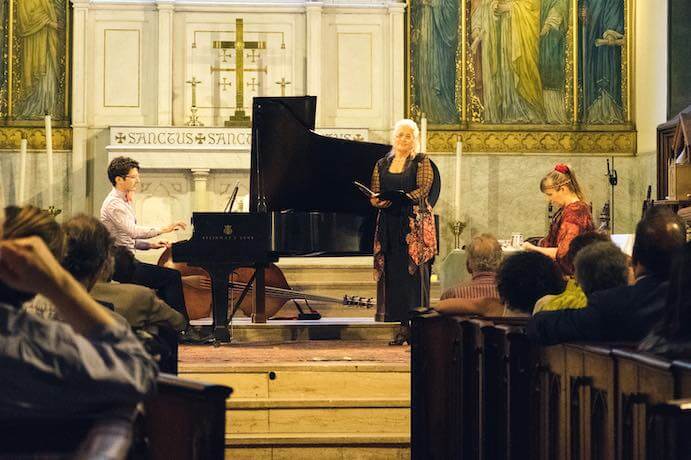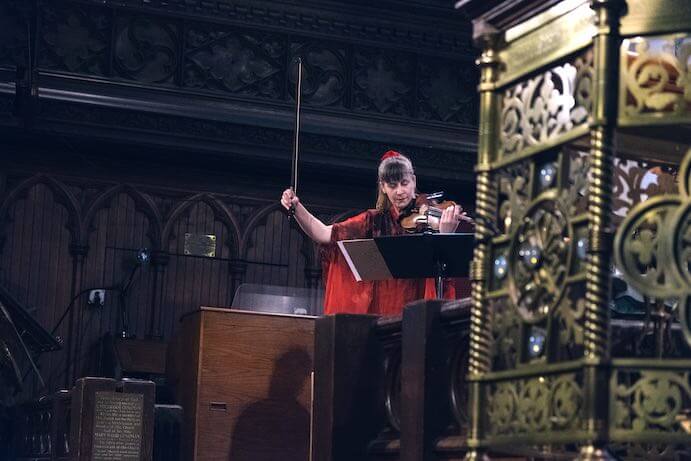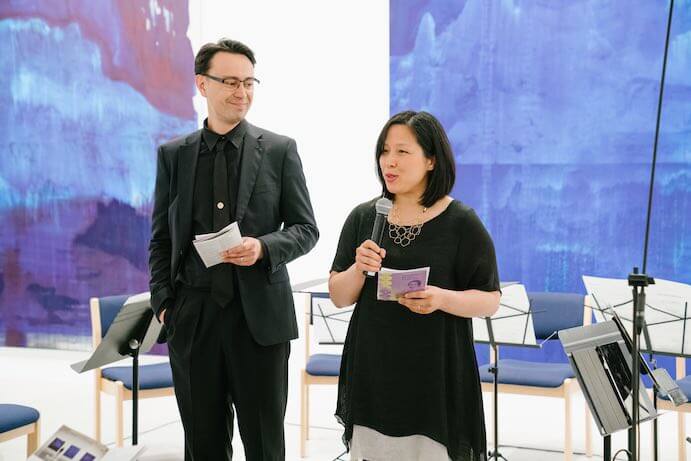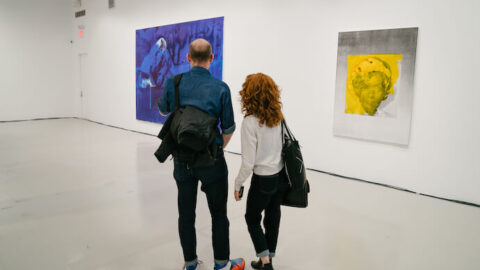This year at the Chelsea Music Festival, there were many reasons to celebrate: 2019 marks the tenth season of the festival, as well as the two-hundredth birthday of the festival’s featured composer Clara Schumann. An appetizing spread of thirteen programs and events spanned from June 6-15 and included straight-ahead concerts, family events and activities, exhibition openings, and a curated dinner.
True to the festival’s tagline of “Hear, Taste, See,” the programming was a feast for the senses. Visual Artist-in-Residence Julianne Swartz performed using her installation of sound-generating sculptural vessels at High Line Nine. This was just one of the ongoing exhibitions, which also featured artists such as Lorna Simpson and Barbara Kalina. On the culinary front, Artists-in-Residence Sawako Okochi and Aaron Israel, along with chefs Silvia Barban, Eric Takahashi, and Maureen Jaeckel, contributed a huge offering of tastes to the dinners, receptions, and intermissions throughout the festival.
I was able to attend two programs this year. The first of them, entitled “If You Love for Beauty,” took place on June 11 at St. Peter’s Episcopal Church.The program featured works by Shulamit Ran (New York premiere), world premieres of 2019 Chelsea Music Festival commissions by Helena Winkelman, Helen Grime, and Nicky Sohn, many works by Clara Schumann, and just one by Robert Schumann. A salon-style staging set the tone for the evening, with the performers sitting on stage in comfy looking chairs. The warm vibe made the large and open sanctuary space feel like a cozy living room filled with friends.

Pianist Andrea Lam opened the concert with Clara Schumann’s Toccatina for Piano, Op. 6 No. 1 (1836). Her light and fluttering performance was nuanced, with compelling attention given to the layering of voices. Later in the program, pianist Robert Fleitz played another of Schumann’s piano works, the Scherzo No. 1 in D minor (1839). Before playing, Fleitz spoke of the opportunity to experience Schumann’s pianism in an embodied way, via learning and performing her music. This capricious and flighty piece is a testament to Schumann’s impressive facility at the instrument. Fleitz brought a drama and intensity to the work that channeled its virtuosity while maintaining a delightful ease and lightness.
Legendary soprano Lucy Shelton sang a beautiful selection of songs by Schumann. Sie liebten sich beide, Op. 13 no. 2 (1844) tells the story of two lovers, tortured by affection and hostility—the double edge of their relationship. Shelton’s voice captured a pristine melancholy, heavy with sorrow and tinged with the peace that comes with acceptance. In Shulamit Ran‘s Love’s Call (2016), the piano bobs through harmonic content with the energy of a wind chime in a gale. Shelton’s lithe and buoyant vocals floated on top with a piercing elegance.
Shelton later performed alongside composer and violinist Helena Winkelman in her Three Poems by Lucian Blaga (2019). This three-movement work evokes celestial elements—moonbeams, stars, and silence are woven together to create its image-narrative. The first movement opens with intertwined whistling from the soprano and glissando pizzicati gestures on the violin.The recitative-like writing for the soprano is interrupted from time to time by virtuosic outbursts on the violin, which then return to the long trills, tremolos, and sustains that fill the piece. For the majority of the work, the duo wandered through a sonic landscape, leaving behind a trail of motivic breadcrumbs behind.

It was soprano Marisa Karchin’s performance of a set of songs by Clara and Robert Schumann and Helen Grime that stole the show. In Clara Schumann’s O Lust, O Lust (“Oh Joy, oh joy”), Op. 23, No. 6 (1853), Karchin’s voice rang with jubilant exhultation. Her dramatic performance and stage presence had the audience captivated by every syllable, and every change in tone. Grime’s song Sie lieben sich beide (2019), which shares the same text by Heinrich Heine as Schumann’s song, was a standout; its slightly dissonant textures, complete with harmonic descending arpeggio material set over low and resonant chords, was like wandering through a strange and beautiful land. Pianist Melinda Lee Masur’s performance was just as stellar, with richly layered and expressive playing.
The concert ended with Nicky Sohn’s If You Love for Beauty (2019), a kind of piano concerto that featured Fleitz and a host of strings. Sohn took inspiration from the form and melodic content of Clara Schumann’s Liebst du um Schönheit. The end result was a pleasing and sweet piece chock full of effervescent cascading arpeggios on the piano, lush string textures, and subtle shifts of color.
The second concert I attended, “Illuminated Blue,” was presented on June 14 at Hauser & Wirth in Chelsea. The four works performed were chosen to accompany Lorna Simpson’s visual artwork, which was on display in the gallery and performance space. Simpson’s works are large mixed-media pieces with a blue-black palette. These stunning works have a kind of depth and vastness to them that is both peaceful and uneasy—something akin being afloat on a large body of open water.

Anna Thorvaldsdottir‘s Illumine for string ensemble (2016) opened the concert, and was by far the strongest and most thematically aligned work on the program. The world of Illumine is one of give-and-take, of things emerging from and disappearing into the depths of a body of sound. Tremolo textures in the strings, always shifting, evoke cyclical shifting waves on the ocean. Later in the work, pizzicati splash into the surface of this sound, causing the sustaining strings to ripple and waver in response. Anna’s work, in much the same way as Simpson’s visual art, has the feeling of gazing into a void—at this sublime vantage point, we can grasp for a moment both a profound beauty and a quiet terror.
The Eurus String Quartet performed String Quartet in One Movement (1929) by Amy Beach, and Aribert Reimann’s arrangement of Clara Schumann’s works in Three Songs for Soprano and String Quartet (2019). Beach’s single-movement quartet tends towards a dissonant and nostalgic romanticism, with a lyrical and wandering tonality. In some moments, material she derived from folk songs of the Alaskan Inuit offers a stark and striking balance to denser writing. In faster sections, the highly engaged Euros String Quartet played with brightness and charm.
Marisa Karchin joined the Euros String Quartet for Reimann’s Three Songs for Soprano and String Quartet. These songs cast aside the beautiful and joyful qualities of love and instead explore its ugly underbelly: these are texts about loss, spite, and despair. Although the arrangements are well set, the brevity of each song left me wanting more.
Jessica Mays’ Out of Blue (2019), a 2019 Chelsea Music Festival Commission, closed out the program. Mays took inspiration from Simpson’s visual art on display. She paralleled the strips of color in Simpson’s work with divisions between sections within movements in her music. Mays scored Out of Blue for winds, keyboard, guitar, percussion, strings, and vocals, which created a sort of fusion jazz-band-chamber-ensemble vibe.

Some moments in Out of Blue were stunning. In one movement, a machine-like coupling of a drumset beat and a chromatic falling bass line erupted before gradually slowing and distending like a generator running out of gas. This motive returned over and over again, sometimes longer and sometimes shorter, sometimes with other instruments or vocalists joining in, or with strings and winds existing in a separate universe, layered on top. At the end of the movement, three vocalists, including Mays, joined in with energetic vocalizing and clapping along with this motive—which, with a kind of dry humor, once again gradually powered down. Despite some successful movements, much of Out of Blue felt a little haphazard and incomplete. Unlike Simpson’s work, in which layered materials added up to a convincing whole, Out of Blue never quite reached such a synthesis.
Summer can be a tricky time to get out and see some great classical music concerts in the city. For many presenters, there is a distinct lull in the period between seasons. Thankfully the Chelsea Music Festival has become a welcome summer staple, overflowing with concerts, events, receptions, gallery openings, and dinners for people of all ages. With a focus on multi-sensory experiences and musical spaces that extend beyond the concert hall, the Chelsea Music Festival is sure to delight audiences for years to come.
























